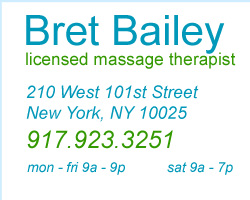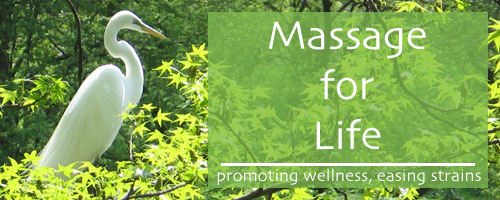Self Care Between Massages
Tennis Elbow
by Bret Bailey, LMT
Tip #6 - May, 2010
If you're a tennis player, statistics show that there's roughly a fifty percent likelihood of experiencing Tennis Elbow in your lifetime. My hope, however, is that you'll be in the fiftyish percentile that experiences only ease and fluidity in this part of your game. Yet, on the off chance that you do find yourself rubbing the outside of your elbow after a match, I hope the following information will prove helpful.
Tennis Elbow, also known as lateral epicondylitis, is a condition in which the forearm extensor tendons become inflamed or stained, from overuse. These tendons connect the forearm extensor muscles (those on the back of the forearm) to the bony prominence on the lateral side of the elbow. Often considered a repetitive stress injury (RSI), or overuse injury, Tennis Elbow is generally caused by micro trauma, or very small tears to the tendons of the forearm extensors.
Possible causes:
- Racquet stings too tight.
- Racquet grip too small. A recent study suggests that differences in grip size of 1/4", over or under ideal size, may not play as significant a role as previously thought. It's believed that technique is a more likely cause, and suggests consulting a tennis pro to have your swing analyzed.
- Hitting wet (heavier) tennis balls.
- HItting the ball when off balance.
- Age - those over 30 are more likely to develop tennis elbow.
- Rapid increase in activity in a short period.
- Overuse related to typing, using a screwdriver, painting, or other repetitive activities.
- Trigger points (hyper-irritable spots within muscle).
Onset can be sudden or delayed.
Sudden onset:
- Can be from a single incident, like hitting a late backhand, which strains tendons of the forearm.
Delayed onset:
- 24 - 72 hours after using a new racket, or after a weekend of home maintenance.
Possible symptoms:
- Pain near the outside of elbow, while extending your wrist against resistance.
- Pain on outside of your elbow, which may extend to your wrist.
- Pain while gripping objects, shaking hands, turning doorknobs.
- Weakness in grip, e.g., having difficulty holding a coffee cup.
Prevention
- Be sure to warm up before activities, and cool down afterwards with stretches.
- Hydrate before, during and after activities.
- Proper technique. The USTA emphasizes the importance of proper technique and suggests increasing strength and flexibility of the forearm (both extensors and flexors) and shoulders.
- Precondition prior to equipment changes. The USTA also notes an increase in injuries following changes in racquets and/or strings, and recommends preconditioning your forearms several weeks prior to such changes. Here the focus is also on increasing flexibility and strength.
Self Care
- Rest (if it hurts when you do it, give it some time).
- Use a tennis elbow brace or epicondylitis clasp.
- Ice
- An Eastern self care approach suggests applying a trauma liniment (die da jiu - which means "hit-fall wine" in Chinese). Massage this into your muscles, instead of applying ice - used by martial artists to reduce inflammation and increase circulation - reapply every few hours. Cooling herbs reduce inflammation, while heating herbs reduce pain and increase circulation to aid in healing. http://www.kamwo.com/shop/home.php?cat=395
Self Massage
Cross-fiber or circular friction to the lateral elbow (to find the muscle attachments, place your fingers on the affected elbow, and extend your wrist as if you are gently revving up a motor cycle, and release. As you continue this revving exercise gently probe the area around your elbow, noticing the tense and release of the forearm extensors. When you've located the musles, follow them up towards the elbow until they meet the bone of your lateral epicondyle.
Trigger Point Self-Treatment
Often pain in the elbow is caused by trigger points. If this is the case, placing a tennis ball between you and the wall, may help. Simply place the tennis ball on the outside of the effected forearm, 3 - 4 inches below the elbow. Now, gently lean toward the wall, using the weight of your body against your arm, and begin to apply pressure. Move your body up and down, to the elbow and back, adjusting pressure when necessary. Do between 6 and 12 strokes, 3 times each day.
Acupressure / Shiatsu
Two Acupressure points are particularly helpful for Tennis Elbow.
LI 4 (Large Intestine 4) - Point between base of thumb and index finger. (To find, place palm of hand on flat surface. Straightening fingers and thumb, drawing them together. Notice the small mound at the base of your thumb and index finger. The high point of this mound is LI 4.)
LI 10 (Large Intestine 10) - Point below elbow crease. (To find, locate lateral edge of elbow crease. Measure two thumb-widths, from crease, towards your wrist.) This should be tender.
Press into these two points repeatedly throughout the day. You can make small clockwise circles with the index finger of your opposite hand. Repeat throughout the day.
The Tyler Twist Using a Thera-Band Flexbar
This I love!
It's a great new treatment that uses eccentric contraction exercises, and a recent study presented at the American Orthopedic Society for Sports Medicine has shown near-incredible results.
To do this exercise, you'll need a specific, reasonably inexpensive tool- a Flexbar. It's a rubber bar made by Thera-Band that's about 12" long, that you can purchase at Amazon.
Once you have a Flexbar, perform the eccentric contraction exercise, as demonstrated in the following video:
http://www.youtube.com/watch?v=zB3TVb8a5mk&feature=related
This is the basic exercise:
- Grasp the Flexbar with the hand on your affected side, holding it as you would a lit candle. Gently bring your wrist to full extension (as if your revving up a motorcycle).
- Then, flexing the elbow of the same arm, bring that elbow to your side.
- Now, with your unaffected arm, reach across the front of your body and grasp the top of the Flexbar (the candle wick part).
- While mainting the full extension of the wrist on your affected side, take your unaffected hand and twist the top of the Flexbar, bringing that wrist into full flexion.
- At this point, the bar will look like a large, twisted liquorice stick.
- With both hands, gently extend you elbows, and bring the Flexbar out in front of you, horizontal to the ground.
- You now have your unaffected arm fully flexed, and your affected arm fully extended.
- Maintaining the flexed position of the unaffected arm, gently turn the affected arm into full flexion, easing the twist in the Flexbar. This eccentric contraction should last about 4 seconds.
(As always, listen to your body, be gentle with your injury, and do not produce pain.)
It's suggested that beginners start with the red Flexbar and do 3 sets of 5 reps, with 30 seconds of rest between sets. Then, progress, when you can easily do 3 sets of 15, up to the green, and finally the blue.
This can be done one a day, for up to 6 weeks.
General Wisdom:
Be sure to see a doctor if:
- You've broken a bone.
- You're unable to bend your elbow.
- Your elbow is swollen and hot, and you have a fever.
- Your elbow looks misshapen.
I hope this information is helpful, and may provide you or others with some relief, between massages.
All the best,
Bret Bailey, LMT
This information is not intended to replace the advice of a physician.
Please feel free to contact me with any comments, questions, or suggestions- just click here. |



